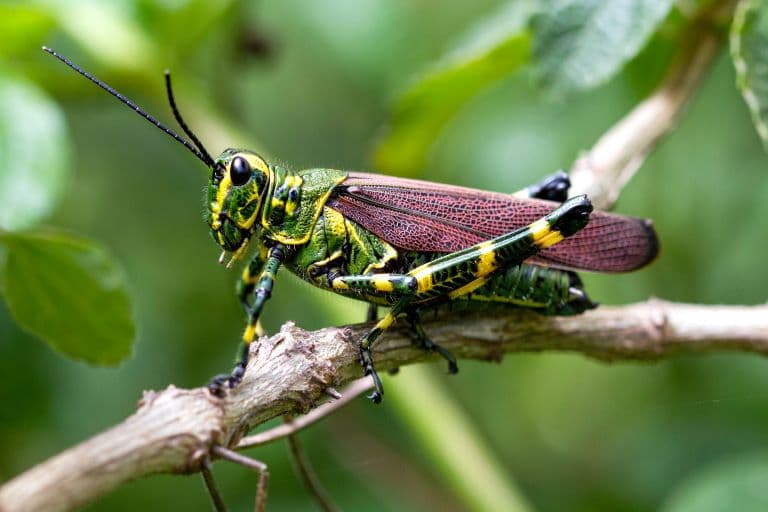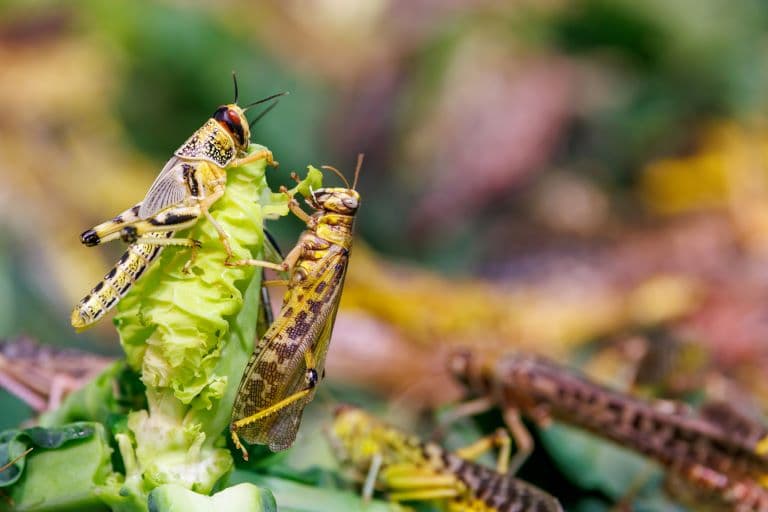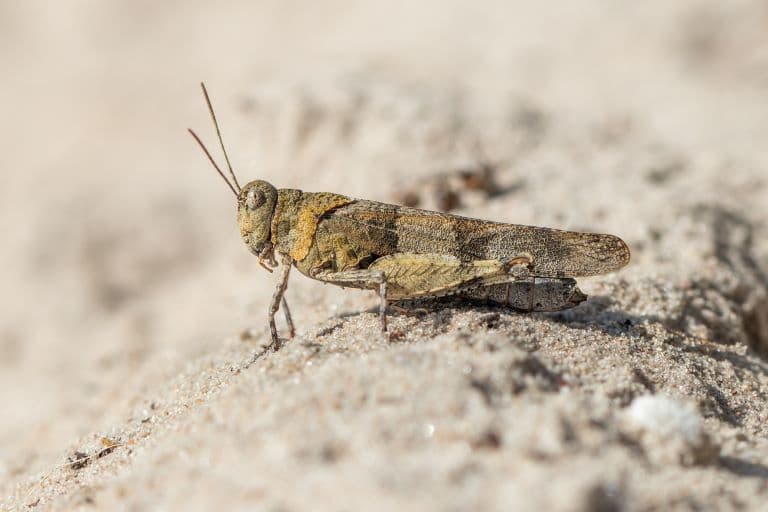Grasshopper Profile
Around 300 million years ago, a divergence happened that still exists to this day. A group of insects decided “This town ain’t big enough for the both of us” and separated into two: half took the day shift, half took the night shift, and it’s likely been that way ever since.
As the sun begins to rise and the night-time chorus of the crickets dies down, a new shift begins, and a new branch of Orthopterans take over the ongoing task of maintaining the soundscape.
Grasshoppers are likely more diverse than you think, and serve a very similar ecological niche to their generally nocturnal counterparts.

Grasshopper Facts Overview
| Habitat: | Mostly grasses, forests, savanna |
| Location: | Worldwide, mostly tropical, some temperate |
| Lifespan: | Around 3 months, depending on the species |
| Size: | Some over 15 cm (6 inches) long |
| Weight: | Unknown |
| Colour: | Varied, usually browns and greens, sometimes brightly painted |
| Diet: | Plants, cereals, some are omnivirous |
| Predators: | Everything |
| Top Speed: | Around 20 km/h (12 mph) |
| No. of Species: | Around 11,000 |
| Conservation Status: | From Least concern to Critically Endangered (IUCN) |
Grasshoppers represent an ancient lineage or primarily diurnal orthopterans. They don’t follow the classic egg/larva/cocoon/adult lifecycle, instead opting for multiple instars of miniature versions of their adult selves.
They’re exceptionally varied, mostly herbivorous insects that play a significant role in the ecosystem.
They make a lot of noise, but jumping is their speciality – at least in the species that jump – and being relatively harmless and quite tasty, they are on the menu for a multitude of insect-eaters.
Interesting Grasshopper Facts
1. They’re old!
Grasshoppers and crickets share a lot of similarities and are related to one another at the order level, but this doesn’t really do justice to quite how far back down the evolutionary ladder they became separated.
For reference, cats and dogs share the same order, Carnivora, and the pair are separated by about 60 million years of evolution. Grasshoppers and crickets have over four times that distance between them, having split from one another in the early Triassic, around 250 million years ago.
This is around the time the dinosaurs showed up, so they might have had something to do with it.
Grasshoppers are almost exclusively herbivorous and might be the oldest such insects on Earth. 1
2. They’re hemimetabolous
Like crickets, grasshoppers forego the whole grub stage and hatch from eggs into miniature versions of the adults, called a nymph.
These nymphs will eat until their skin is stretched tight, split it, shed it, and continue eating. They’ll do this five times before they reach maturity, and on the last one, the sex organs and wings (if they have any) finally show up and they can get their groove on.
This lack of a pupal stage is known as hemimetabolism or partial metamorphosis. 2
3. They come in all shapes and sizes
While the little ones look much like the big ones, the big ones can differ quite a bit from one another. The standard archetype for a grasshopper – that is, what people would draw if you asked them to – is a short-horned grasshopper. But there are many other types!
There are matchstick grasshoppers whose legs stick out at 90 degrees for some reason; pygmy grasshoppers, who look like cartoon grasshoppers, pieced together with coloured clay; there are giant twiggy grasshoppers that resemble stick insects and ones that look like dead leaves.
Grasshoppers even change in the way we define them when they come together and swarm. 3

4. They can swarm
Those standard-looking short-horn grasshoppers are the Acrididae, and they’re quite famous for messing with people’s food.
Many of these species respond to overcrowding by changing colour, eating more, and then breeding a lot and exploding in number. This extreme response has led to countless human deaths from famine over the millennia and is triggered by a stimulus as simple as ticking the grasshopper’s back leg.
This is the grasshopper equivalent of Hulk Mode and the resulting furious swarming animals are called locusts. There’s no taxonomic difference between a grasshopper that swarms and a locust, it’s just the name we give to them when they’re being total bastards.
Locusts can swarm in their billions, and it all kicks off when their legs rub together too many times over four hours and they start getting mad. This simple stimulus has been identified as the trigger for swarming and the cause of famines of biblical proportions throughout history.

5. They can jump
Grasshoppers are pretty mid insects by most metrics. They have basic compound eyes, some ocelli, an open circulatory system and a simple pump, typical of most insects. But one area in which they excel is their ability to jump.
Their back legs are immensely powerful and a large one can jump well over a meter, accelerating from the ground at 20 g. To achieve this, they do much more than simply contract muscles.
They use a specific configuration of contractions to slowly increase stored energy in the muscle and then rapidly release the leg, functioning like a crossbow to twang the insect forward.
6. They talk a lot
Females quietly chirp and are reasonably peaceful animals, but the males are the ones who make all the racket. It’s their job to express how ready to reproduce they are, so, like students on a Friday night, they make sure everyone knows it, loudly and obnoxiously.
But these songs also express a variety of other messages, like the urge to come and hang out, or just a communication of peace. Songs help these long-distance jumpers from losing one another and getting too dispersed.
These sounds are caused by rubbing a set of pegs, built into the rear legs, against specialised veins on the back of the wing. This creates a loud, grasshopper “chirrup” that can be heard from a long way off. 4

7. They have a lot of enemies
These noisy, tasty, and mostly defenceless animals are top of the menu for animals of all sizes. Camouflage helps, and many can change colour to suit their surroundings.
Some are simply built to look like leaves or sticks, and others have warning colours on their wings that make them look a bit dodgy and give would-be predators a second thought.
Some even are a bit toxic, so avoid predators by letting them know that, most though, are bluffing, and while some can secrete foul, deterring juices from their mouths, this isn’t enough to keep many birds and mammals away, and the grasshoppers provide diurnal predators with a significant amount of their biomass as a result.
Grasshopper Fact-File Summary
Scientific Classification
| Kingdom: | Animalia |
| Phylum: | Arthropoda |
| Class: | Insecta |
| Order: | Orthoptera |
| Suborder: | Caelifera |
| Family: | 7-8 Superfamilies |
Fact Sources & References
Buglife (2023), “Grasshoppers vs crickets: what’s the difference between these two jumping insects?”, discoverwildlife.
- “grasshopper”, Britannica.
- “Neotropical Stick Grasshoppers”, iNaturalist.
- “Stridulation”, Science Direct.
